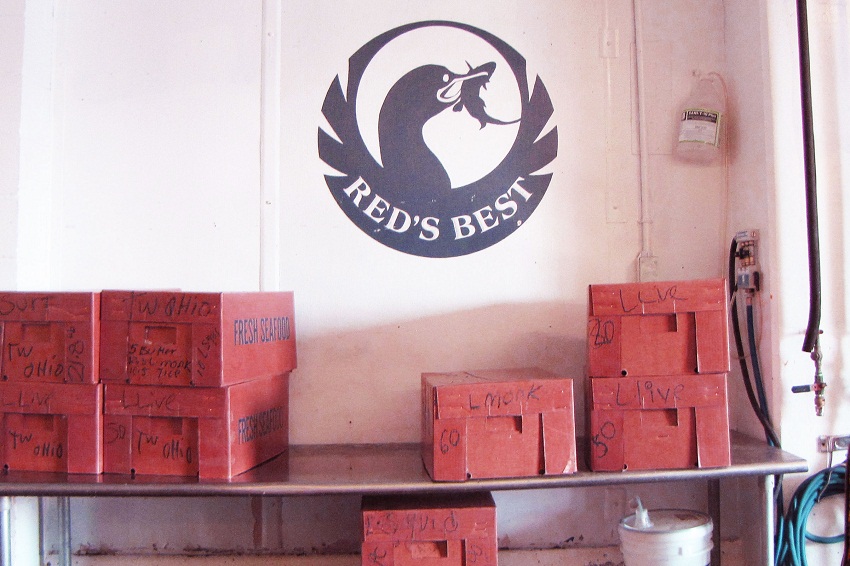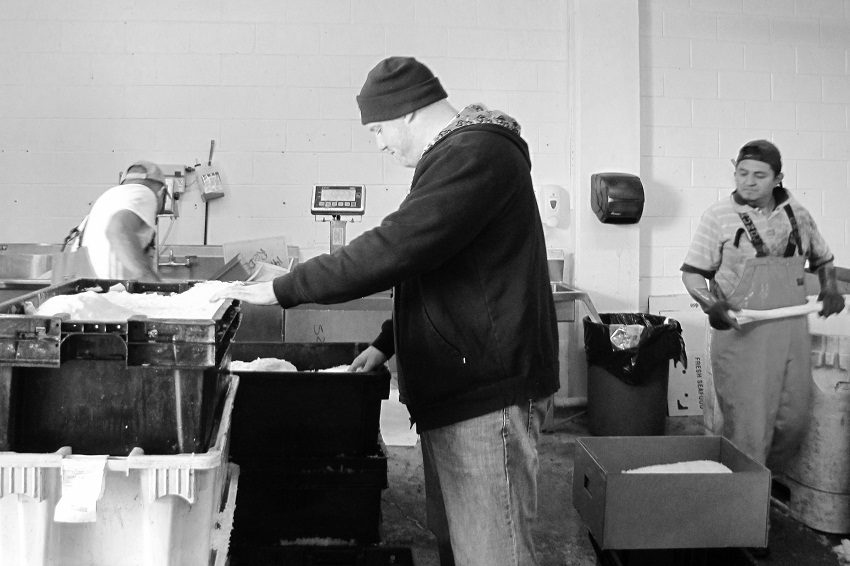One Fish, Two fish, Red’s Fish, Bluefish: A Morning With Seafood Purveyor Red’s Best
Welcome to Supply Chain, where we go behind the plate to get a feel for the day-to-day of Boston’s most relied-upon restaurant purveyors.
I’ve arrived at Red’s Best—a wholesale seafood distributor on Boston’s fish pier—right in the middle of the morning packing rush. The room is strangely loud and quiet simultaneously in the wake of so much productivity; plastic tubs scrape across the concrete floor, the clanging of forklifts echo, and a tinny radio blares top 40 hits, but everyone is viciously focused on the task at hand.
A stack of crates that comes up to my shoulder teems with razor clams. To my left, a guy is guiding the tubular bivalves down a silver chute into individually boxed orders. The clams are oozing out of their casings, dangling out of the holes in the crates, until founder Jared Auerbach comes by and flicks them all lightly, at which they all yo-yo back up into their shells.
“These guys were in the water this morning,” he says, watching as the clams begin their squishy and fruitless bid for escape once more. “We move fast.”
Auerbach, decked out in a worn Red Sox hat and a forest green hoodie, started the company in 2008 after earning his fishing stripes on commercial vessels in Alaska and Cape Cod. After spending time among their ranks, he set out to create a business where the focus would be on each individual fisherman, rather than just what they caught. The result is a humming operation that mostly deals with high-end wholesalers and works with up to 150 small boats and hand-line fishermen.
Vice-president of sales Eric Morris (pictured) appears, and the two launch into a walk-through of their daily process, their voices lifting above the din. At night, especially in the spring and summers while they’re busy, all of the drivers congregate on the dock at 2 or 3 a.m. to collect the product into the coolers. By 5 a.m., everything has been parceled into totes and vats. While it is gathered on the main floor and boxed up, Morris is on the phone, selling, and in the late morning and early afternoon, it gets divvied up. By 6 p.m. tonight, the room will be empty.
The sheer number of fish in the room—some the size of my fist and some the size of my arm—is mindboggling. Red’s deals with 60 different items from Massachusetts alone; Auerbach points to boxes of local squid, live scallops, surf clams, butterfish, a bulging bag of monkfish livers, and another of 3,000 monkfish heads.
Every package goes out with a unique label, complete with the fisherman’s name and where the product was caught, along with a QR code that sends you to a more detailed biography and breakdown. The idea is to literally wear traceability on the company’s sleeve.
“We want to give chefs a tool that allows them to prove they’re sourcing responsibly,” Auerbach explains. “It’s important to all of us that we support our local fishermen right? When chefs are actually doing that, we want them to be able to tell that story to whoever wants to hear it.”
“We’re really just connecting you to the boat, you know what I mean?” Morris continues. “We’re completely transparent, so that’s a big appeal for those that are concerned about traceability.” It might seem like a no-brainer, but not everyone is clamoring to slap a calling card on the contents of their walk-in. The mislabeling of seafood on menus, for example, has continued to be an issue for Boston year after year. Red’s is hoping to expand soon, with a separate area for chefs to visit and check out the selection firsthand. The gesture is part of an ongoing effort to encourage cooks and eaters to know exactly where their seafood is coming from.
“It sounds so simple, but it’s scary how often that doesn’t happen,” Auerbach says, shaking his head incredulously. “We’re all standing around like, of course we unload local fish and sell it. That’s obvious. But we unload some boats at this beautiful little harbor in Plymouth, and there are some restaurants right down the road that are selling tilapia from Ecuador. Come on!”
Besides transparency, the crew at Red’s is very much behind the “trash fish” movement sweeping the restaurant industry, if not in name, then most fervently in practice. A dedication to telling their fishermen’s stories and cultivating lasting relationships means an equal dedication to diversifying their offerings.
“We’re really big on turning people on to under-utilized species that will become the next big thing,” Morris says. “That’s important to us, like skatelings and monktails and dogfish and scup. These are awesome products that are local, sustainable and they’re inexpensive. Pushing those products, and getting the word out to chefs, is really what we want to do to help some of these fishermen make a solid living.”
“Totally. It all goes back to keeping it local,” Auerbach chimes in, before ducking out to answer a call. “Ten years ago, people were trying to distinguish themselves by how exotic their product was. Getting something funky from the other side of the planet was the key. The point is, we don’t have fish from all over the world.”





